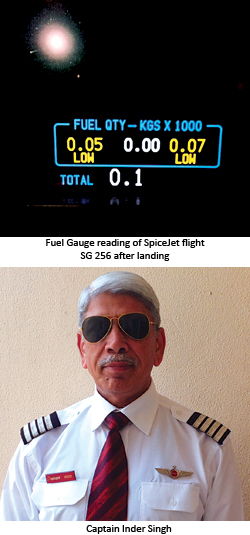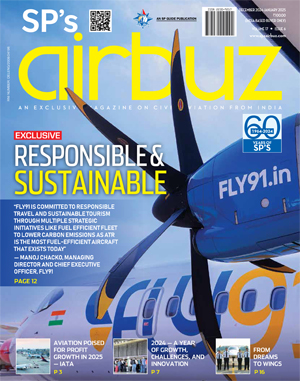Unsung Hero
Captain Inder Singh displayed excellent judgement when he decided to divert to Jaipur once it became amply clear that the Delhi weather would not improve in the next half an hour. It was the additional fuel that he has asked for and timely decision for diversion that ultimately saved the lives of 182 passengers onboard the SpiceJet flight.

Winter in Delhi is synonymous with fog, and delayed and disrupted flight schedules. Airlines generally gear up for just this contingency by upgrading the training status of their crew and fine-tuning rosters to ensure that adequately qualified crew are available to operate scheduled flights, minimising disruption to the schedule caused by delays and diversions on account of fog.
Late at night, on January 5, 2014, there were two events of significance for the airline industry in India. In both these episodes, the crew were confronted with situations that could have proved disastrous and could have led to heavy loss of life.
Delhi Fogged Out
Air India flight AI 890, an Airbus A320, operating on Guwahati-Delhi sector, was nearing Delhi at 2200 hours. There were 173 passengers and crew onboard with Captain Jalal Vats in command. At about the same time, SpiceJet flight SG 256, a Boeing 737-800 operating from Goa to Delhi, also arrived over Delhi with 182 souls onboard with Captain Inder Singh, an ex-Indian Air Force (IAF) pilot in command. The low visibility procedure (LVP) training status of Captain Vats is not known. LVP training status of Captain Inder Singh was up to Cat II.
The weather status in respect of runway visibility at Delhi airport was below the minimum required by both these flights for landing. In this situation, it was clear to both the Commanders that a landing at Delhi was not possible and hence both decided to divert, a decision most appropriate under the circumstances. As the planned diversion destination for both flights was Jaipur, both the Commanders set course accordingly for the diversion airfield. The visibility at Jaipur airfield at the time of initiating the diversion was within the minimum required for landing.
During the descent procedure upon arrival in the vicinity of Jaipur, the Commanders were intimated by air traffic controller (ATC) that the visibility was deteriorating. However, since they had already flown the distance to Jaipur and had depleted their fuel reserves meant for diversion, they were then not left with adequate fuel to fly with safety margin to any other airfield. Captain Vats announced his intention to land at Jaipur the visibility on the airfield being beyond his minima notwithstanding. Captain Inder Singh also took a similar decision. In the landing sequence, AI 890 was ahead of SG 256. The ATC cleared SG 256 for landing behind AI 890. The two aircraft were once again informed of further deterioration of visibility at Jaipur. So far, all operations were completely copybook style.
Decision-Making Dilemmas
When SG 256 with Captain Inder Singh at the controls was about 15 nautical miles (nm) from touchdown, on the radio he monitored an aircraft ahead of AI 890 executing a missed approach. AI 890 that was next in the landing sequence was then cleared by ATC to land. When SG 256 was about six nm from touchdown, he monitored an emergency transmission from AI 890 asking for crash assistance. As ascertained later, AI 890 had botched up the landing in the extremely challenging weather conditions prevailing. Apparently, the aircraft had veered off the runway with burst tyres, damaged a wing and with passengers thoroughly shaken, had re-entered the runway. AI 890 then declared that as he was not able to taxi the aircraft, the runway was blocked.
With the only runway at Jaipur suddenly unavailable, landing there was not possible. Captain Inder Singh, therefore, abandoned the idea of landing and executed a missed approach. He was now in a difficult situation as he had diverted from Delhi with fuel reserves close to his minimum diversion fuel (MDF) and had consumed fuel in the transit from Delhi to Jaipur. And now six nm short of Jaipur, he finds that the runway is not available to him for landing. His predicament was unenviable indeed!
He was now left with no options spelt out in the book. He now had to draw on his vast experience, airmanship, rigorous training and knowledge acquired while serving in the IAF. In these days of tight control in the airline industry on fuel uplift, careful planning based on anticipated conditions is an essential prerequisite. Requirement for additional fuel uplift has to be justified. It would be pertinent to mention that while planning the flight at Goa, Captain Inder Singh asked for 300 kg of fuel over and above the recommended minimum, solely to cater to the anticipated poor visibility conditions in North India in general and at Delhi in particular. He displayed excellent judgement when he decided to divert to Jaipur when he still had 500 kg of fuel above his MDF once it became amply clear that the Delhi weather would not improve in the next half an hour. It was this additional fuel and timely decision for diversion that ultimately saved the lives of 182 passengers onboard the SpiceJet flight.
With no possibility of landing at Jaipur, Captain Inder Singh decided to return to Delhi which was the closest airport, and most importantly, the only airport in India which is approved for Cat IIIB operations. The First Officer, who was reasonably experienced, panicked at the decision of the Commander. Inder Singh employed all the airmanship, management and crew resource management (CRM) skills at his command to convince the First Officer that as the Commander, he was responsible for the safety of the airplane and all onboard. He managed to calm down the First Officer and got him to perform as a full-fledged crew member. The first task assigned to the First Officer was to declare Mayday, a radio call that indicates to the ATC that the aircraft is in extreme emergency.
Having received a Mayday call, the ATC at Delhi responded immediately according all priorities required to SpiceJet flight SG 256. Delhi has six runways, three easterly and three westerly. From Jaipur an approach to Delhi on any easterly runway is considerably shorter than an approach on any westerly runway. On receipt of the latest weather report from Delhi, Inder Singh made a quick professional assessment that from the point of view of runway visibility, an approach on the westerly runway was better than on the easterly runway. Therefore, despite the longer distance and hence greater time in air, he elected to land on the westerly runway. At this stage, SG 256 had fuel for 15 minutes of flying and the time to touchdown was 13 minutes. With complete calm, cool and cold blooded precision, he planned his LVP approach for runway 28, the main westerly runway at Delhi.
During the flight from Jaipur to Delhi, he continued to converse with the First Officer to put him at ease. He also planned for the contingency of engines flaming out due to fuel starvation, in which case he would have to put the aircraft down in an open field, an extremely hazardous and difficult proposition especially at night.
A Happy Ending
Captain Inder Singh carried out a perfect LVP approach and touched down on Runway 28. As the ground visibility was very poor, he was assisted by a “follow me” vehicle to reach the parking bay by which time, as per the fuel gauges, the aircraft was left with 50 kg on the left tank and 70 kg on the right tank, a total of 120 kg. That would have given him another two minutes in the air.
Captain Inder Singh was confronted with an extraordinary situation which was not of his own making. However, it was through extraordinary professional competence and courage that he handled a challenging as well as potentially dangerous situation and carried out a safe landing at Delhi with no loss of life, injury to humans or damage to property. And all this at night under conditions of blinding fog! When pushed to the wall against all odds, he performed and came out on top.
Exemplary Courage
This was an act of the ‘most conspicuous courage’ and cool-headed professionalism, display of superlative airmanship and CRM skills against formidable odds. This is an event that SpiceJet, the flying fraternity, the Indian civil aviation establishment and the nation should be proud of. The episode falls in the same category as the remarkable feat by Captain Sullenberger of the US Airways who successfully put his aircraft down on the Hudson River with full load of passengers following loss of power to both engines. There was no loss of life or injury to those onboard.
After the successful ditching of an airliner in the Hudson River, the gratitude of the nation was clearly manifest. In a ceremony, Captain Sullenberger was felicitated personally by President George Bush. Thereafter, Sullenberger was awarded the Masters Medal by the Guild of Air Pilots and Navigators. The San Ramon Valley Fire Protection District Chief Richard Price presented Captain Sullenberger with the district’s highest award, the Medal of Valour. In 2009, the distinguished professional was awarded the Founders’ Medal by The Air League and in the following year, Sullenberger was appointed “Officer of the Legion of Honor”.
For display of extreme courage in the face of grave danger and to save the lives of those onboard, Captain Inder Singh does indeed deserve a national award. It is only appropriate that his employer, SpiceJet, take up this case with the Government of India.





